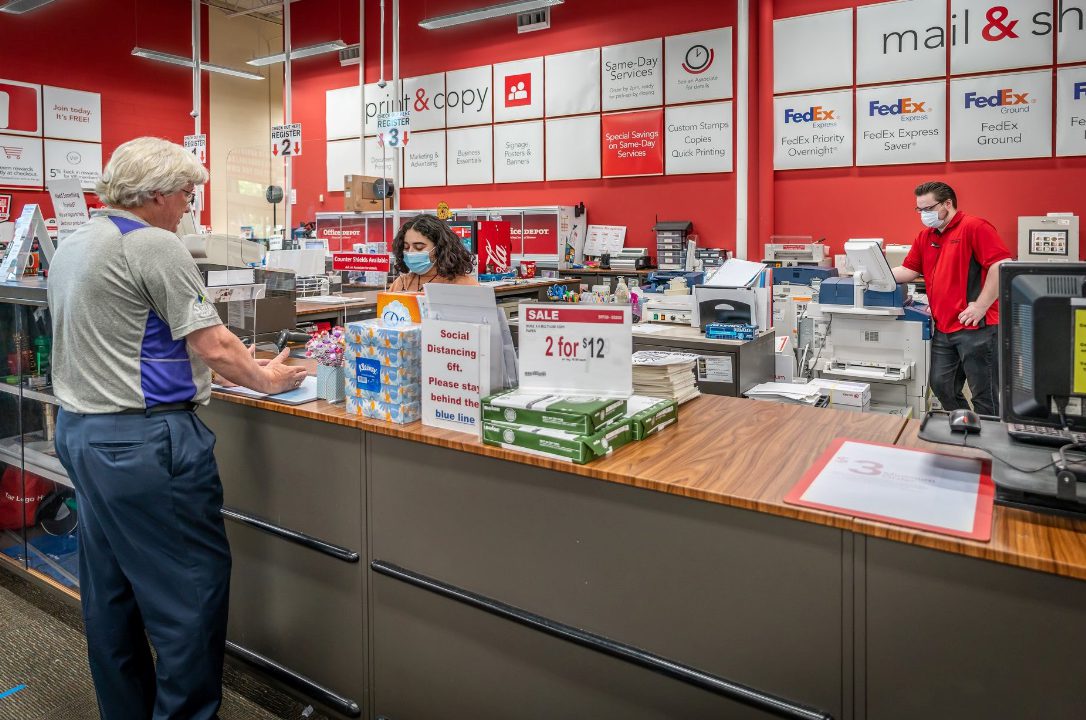Office Depot’s Business Journey: Quickly Successful Honeymoon and Unpredictable Downsizing
The Office Depot Corporation is an American office supply retailing company headquartered in Boca Raton, Florida. Office Depot, Inc. has once ranked as the second largest operator of office supplies superstores in the United States, trailing only category leader Staples, Inc. The company operates 1,400 retail stores, e-commerce sites and a business-to-business sales organization, offering a full range of office supplies and office furniture, business machines and computers, and computer software. Its distribution channels include direct mail, contract delivery, Internet web site, and business-to-business e-commerce. Office Depot also owns Viking Office Products, Inc., a wholly owned subsidiary and one of the leading direct-mail marketers of office products in the world. International operations, involving a full array of distribution channels, extend to 23 countries. Nearly one-quarter of the company’s revenues are generated outside the United States.
Along with rival companies Staples and Office Club, Inc., Office Depot was a pioneer in the field of office supplies discount retail. The three companies were founded within months of each other in 1986 in three different corners of the United States–Office Depot in Florida, Staples in Massachusetts, and Office Club in California. All of them saw opportunities in selling office supplies to small businesses at bulk discount rates that had previously been the privilege of larger companies. Since small businesses had never purchased supplies in quantities large enough to receive bulk discounts, they had been at the mercy of conventional retailers who, in the absence of price competition, could sell at manufacturer’s suggested retail prices and take markups of as much as 100 percent. Buying directly from manufacturers instead of wholesalers and keeping overhead low, a discount retailer could offer goods from 20 to 75 percent off of full retail. Another trend that proved advantageous for these three companies was the advent of warehouse-style discount retailers in the 1980s; what Price Club had done for general merchandise and what Circuit City had done for consumer electronics, Office Depot, Office Club, and Staples sought to do for ballpoint pens and legal pads.
Office Depot’s Success: Rapid Growth Since Its Inception
Office Depot was founded in Boca Raton, Florida, by entrepreneur F. Patrick Sher and two partners, Jack Kopkin and Stephen Dougherty. The company opened its first retail store in Fort Lauderdale in October 1986, and it proved successful enough that two more Office Depot stores appeared in Florida by the end of the year. In 1987, the company continued to grow rapidly, it opened seven more stores in Florida and Georgia and sales topped $33 million. Sher did not have long to savor his success, however, for he died of leukemia scarcely a year after his first store had opened. He was succeeded as CEO by David Fuente, an experienced retail executive whom Office Depot lured away from Sherwin-Williams, where he had been president of the paint stores division.
Office Depot gained the distinction of being the first of the three original discount chains to turn a profit for a period of four consecutive quarters, which it did during the last two quarters of 1988 and the first two of 1989. The company achieved its success with stores that resembled nothing so much as warehouses. Their decor was functional and unassuming, in a style described by a reporter for Fortune as “plain pipe rack,” with merchandise stacked floor-to-ceiling on steel shelves. As David Fuente explained it, “Customers pick only from the first six feet of ‘shelf’ space anyway. So, we use the area above ‘for storage.'” By 1989, Office Depot stores were averaging $150,000 in sales per week. Of course, lack of concern for the aesthetics of interior design characterized the company’s competitors, as well. Office Depot held an edge in that commercial rents were lower in the South than elsewhere in the United States, allowing the company to build exceptionally large stores and still keep overhead costs relatively low.
In 1990, Office Depot grew dramatically, expanding beyond its regional base in the South into the Midwest. Much of that expansion was financed by the sale of 3.6 million shares of stock for $41 million to Carrefour, a French chain-store concern with subsidiaries throughout Europe.
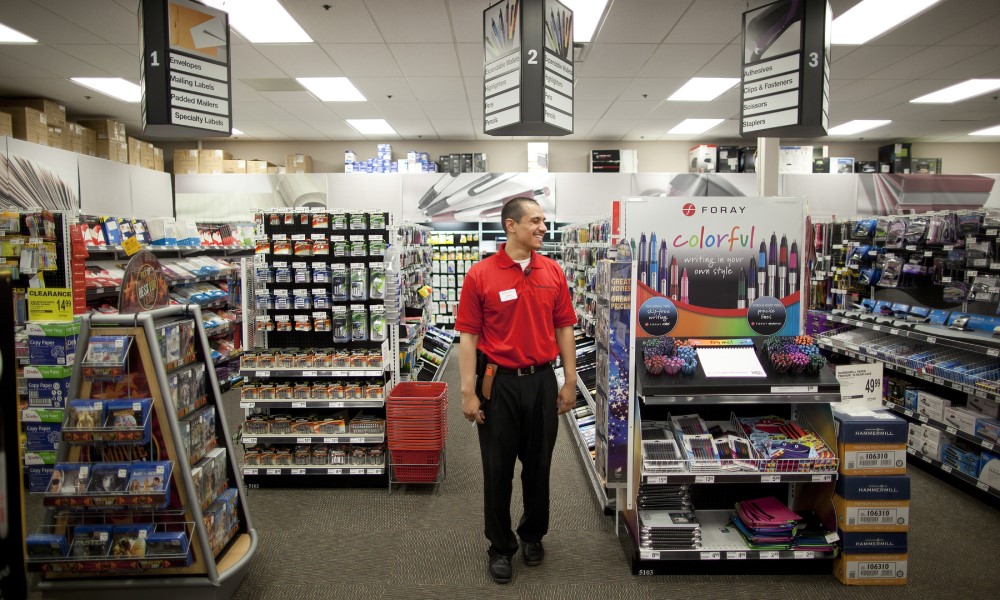
The office supply discount field became more crowded and competitive in the early 1990s as other companies, including OfficeMax and BizMart, joined the lucrative industry. With the struggle for market share becoming more vigorous, Office Depot and Office Club decided to merge in 1991. The move solidified Office Depot’s position on the Pacific Coast in one swoop by eliminating a major competitor and giving it a substantial number of new stores in a regional market where the company previously had only a slim presence. For its part, Office Club had not fared quite as well as its fellow discounting pioneers; during the four quarters that constituted Office Depot’s first profitable one-year period Office Club lost $2.7 million, compared to Office Depot’s gain of $5.1 million and Staples’ narrower loss of $1.9 million. The merger, therefore, proved advantageous to Office Club as well.
In 1991, the company saw its sales of office machines, including personal computers, begin to grow by leaps and bounds, and the company began to emphasize this side of its business more strongly. The company has claimed in the interview that 10 percent of all fax machines sold in the United States were sold by Office Depot. Store layouts were redesigned so that more machines could be put on display. The company began selling not only PC clones by Packard-Bell and Compaq, but also the real thing–in August 1991 IBM agreed to let Office Depot sell its PS/1 computers and around that time Apple gave permission for them to sell the Macintosh Performa line as well.
In 1992, Office Depot went international, acquiring HQ Office International, the parent company of the Great Canadian Office Supplies Warehouse chain, which operated seven stores in western Canada.
In addition to expanding into new geographic areas, Office Depot began expanding its customer base. Originally catering to businesses with 20 or fewer employees, Office Depot decided to attract larger business by acquiring contract stationers and integrating them into its retail business. The company acquired the office supply operations of contract stationer Wilson Stationery & Printing, a subsidiary of Steelcase Inc. The deal was valued at $16.5 million. In the next year the company bought three more contract stationers.
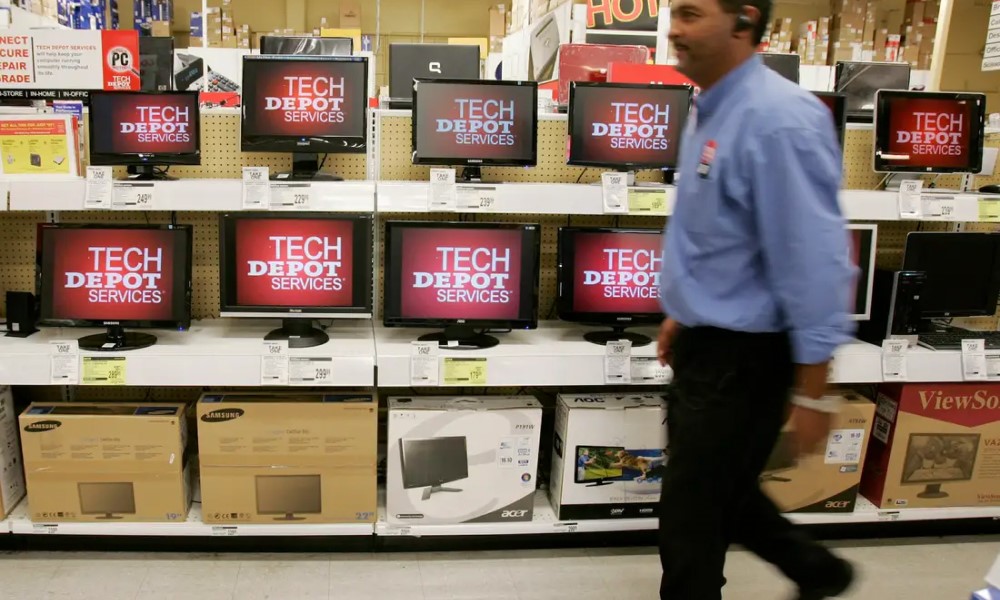
Having successfully moved into the established retail office supply market, Office Depot was confident they could challenge the existing system that served larger businesses. CEO David Fuente told Forbes that, “We’re all selling the same stuff; we’re all selling legal pads and pens and pencils, and we all buy from the same place. The real difference in performance is going to be: Are you pricing them better? Giving better service? Delivering better? The difference is not in the strategy but in the execution.” Office Depot has felt confident that the more diverse customer base should make the investment worth it in the long run.
The company saw $2.6 billion in sales in 1993, with $63 million in profit. By 1994 Office Depot had grown to 362 stores, which still followed the company’s original concept–warehouse-like buildings that stocked office supplies at 30 to 60 percent off manufacturer’s list prices. The company’s closest competitor, the Kmart Corporation subsidiary OfficeMax, was only half its size. Not satisfied, Office Depot planned to double the number of its stores in the next five years.
Office Depot’s Failure: Struggling to Regain Supreme Regime
As the ill-fated Staples deal unfolded, Office Depot had placed its expansion plans on hold. Then when the deal died, the company scrambled to make up for lost time, opening new stores rather haphazardly–entering new markets, where competitors were already entrenched, with just a couple stores, and making some poor choices in regard to specific store locations. Office Depot was also hurt by heightened competition from warehouse discounters, particularly Costco Wholesale Corporation and Wal-Mart Stores, Inc.’s Sam’s Club, who made aggressive moves into some of the most profitable office supplies categories, including computer paper, toner, and ink–forcing price cuts. Sales and profits were negatively affected, and Office Depot began missing some analysts’ projections. After second-quarter 2000 earnings dropped 22 percent, the company’s board reacted by easing Fuente out of the CEO slot and into the position of nonexecutive chairman. Bruce Nelson was promoted to CEO from his previous position as international president. Nelson had joined Office Depot as the president of Viking Office Products, and earlier in his career had garnered more than two decades of senior management experience at Boise Cascade Office Products.
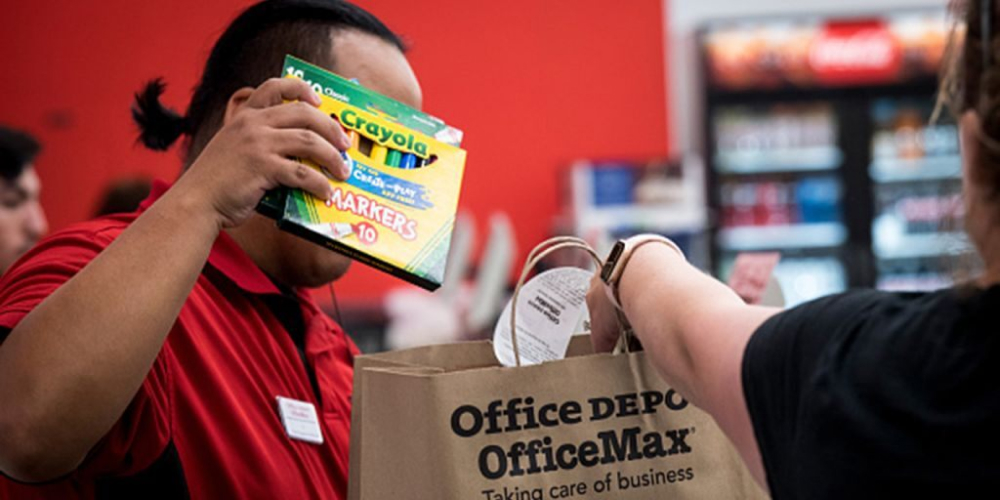
Nelson spent the next several months making changes to top management and launching a thorough review of the firm’s operations to identify underperforming outlets and weak markets. In January 2001 he announced that Office Depot would close 70 of its 888 North American stores, leaving the following markets altogether: Cleveland; Columbus, Ohio; Phoenix; and Boston. Expansion for 2001 was pared back to 50 new stores, with the new outlets being about 20,000 square feet each, about 5,000 square feet smaller than the average existing store. Nelson also aimed to refocus the stores on small and medium-sized businesses by eliminating a great deal of consumer-oriented merchandise, such as DVD players and children’s computer software. In all, about 1,800 products were to be cut; these represented about 20 percent of the total number of products but generated only about 2 percent of sales. In connection with this restructuring, Office Depot recorded an after-tax charge of $260.6 million for the fourth quarter of 2000, leaving profits for that year to stand at a much reduced $49.3 million.
After nearly four years of declines in quarterly same-stores sales (sales at stores that have been open for more than one year), the company appeared to have turned the corner during the first half of 2004 when it posted two consecutive quarters of 3 percent increases in same-store sales. The company was also busy with a number of new initiatives. In February it rolled out its first-ever customer loyalty program, Office Depot Advantage, which rewarded customers who spend as little as $200 in a three-month period with a gift certificate good for future purchases. To help ramp up expansion efforts, the company agreed to buy 124 former Kids “R” Us stores from Toys “R” Us, Inc. for $197 million in cash. The deal was later reduced to 109 stores, and Office Depot planned to resell or sublet about half of the total, but 45 to 50 of the stores were to be converted to the Office Depot format. Many of the acquired stores were in the Northeast, and the company announced an aggressive expansion into that region, a stronghold for its two main rivals, Staples–now the number one U.S. operator of office supplies superstores–and OfficeMax. Overall, in an attempt to close the gap with Staples, which had 1,400 stores, the 900-unit-strong Office Depot aimed to open 80 new stores in 2004 and then 100 new stores in each of the following three years. The new stores were to feature a new store format called Millennium 2. Nelson told the Palm Beach (Fla.) Post: “We worked to create a store that was easier to shop, less expensive to open and more efficient to operate. This serves as our foundation to enter a new era.” The format emphasized grouping product categories together in the way customers use them and also featured increased cross-merchandising. Also significant was that the stores began showcasing a new line of fashion-forward furniture created by Emmy Award-winning designer Christopher Lowell.
Office Depot’s Huge Success and Fist Bumps Turned Back
Following this milestone and the company’s quarterly earnings report on November 4, both Office Depot insiders and industry watchers have expressed a surprising amount of optimism despite Office Depot’s challenges.
There are many reasons to view the merger of Office Depot and OfficeMax as a smart defensive maneuver, enabling the combined chain to more effectively compete with brick-and-mortar and online rivals. Office Depot has laid out an aggressive strategy to expand margins and grow its business and has so far executed on cost cutting plans to the cheers of the market.
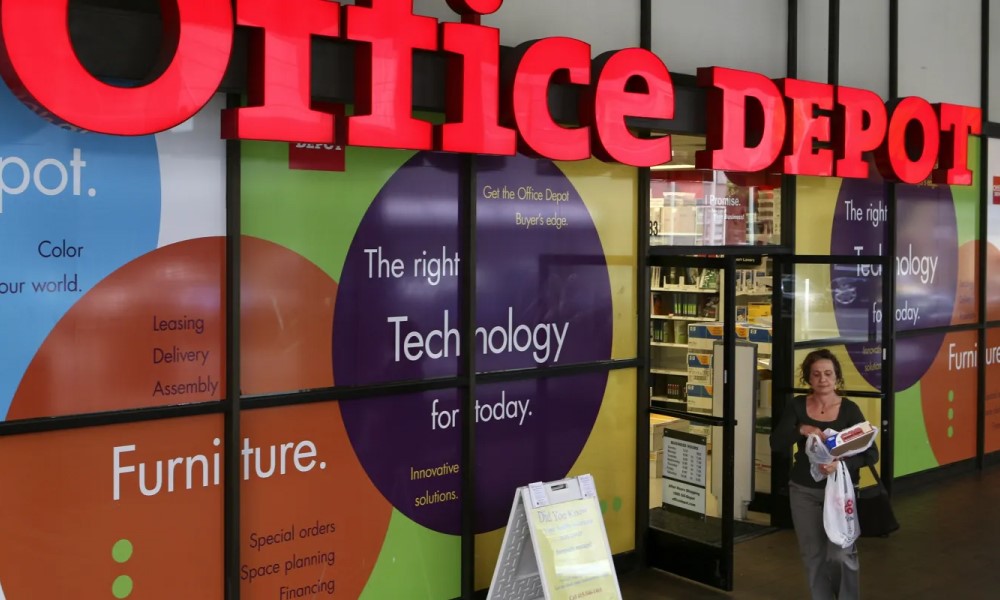
While the first 12 months as a merged company has provided an endless number of clear opportunities for progress and to tout early successes, the coming years will prove much more difficult. Facing countless competitive and secular headwinds, the retailer has to improve its core business execution, expand sales beyond its traditional customer base and sales channels, and reengineer its value proposition. One year into its merger, Office Depot’s recent honeymoon phase has nearly ended, and pressure will only grow on its core business. As a larger and leaner company Office Depot is managing to survive at the moment, but if it underperforms in any of its strategic goals its already weak position in the market will only get worse.
One-year into its merger, and despite a very long list of looming threats to its business, Office Depot’s CEO recently went out on a limb to describe its union with OfficeMax as a “huge success.” While this statement may be a bit premature, the company has good reason to be optimistic. Synergies in a merger of this size can generate a quick improvement in profitability, which in turn provides more resources to make strategic investments and can produce an appreciation of its market value. Meanwhile the company’s larger combined scale is very much a competitive improvement in a consolidating market.
Since it merged with OfficeMax in November 2013, Office Depot has made cost reductions a cornerstone of its near-term strategy. This strategy has taken shape in the form of 400+ store closures through 2016, a plan to reduce store footprints, a focus on eliminating supply chain redundancies, divesting business abroad, trimming expenses such as advertising, and aligning its in-store and online operations, among other initiatives.
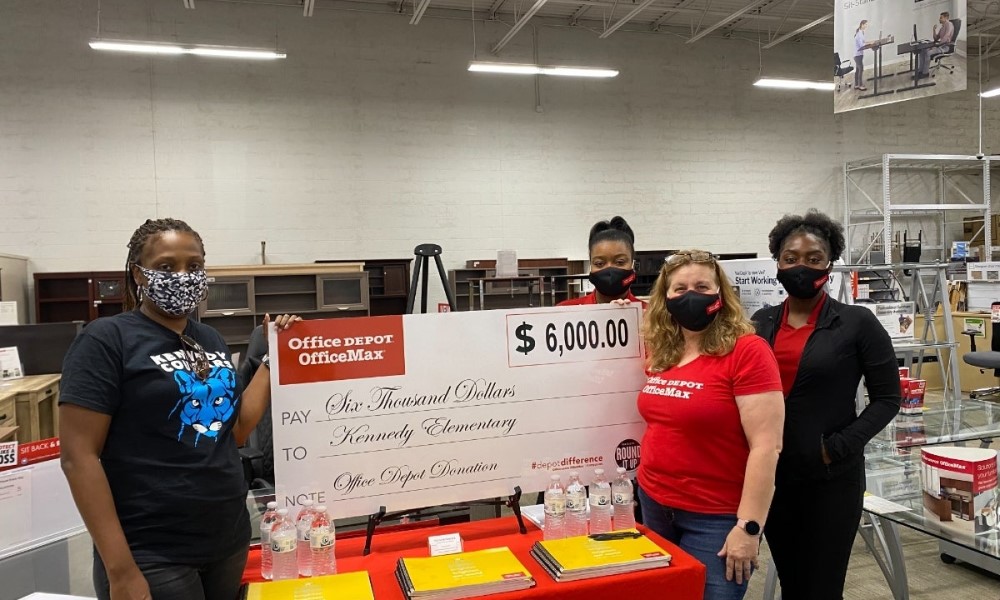
So, has this strategy worked? Is the company as successful as it believes? Wall Street is certainly bullish on Office Depot’s new direction. The company’s shares have been on a tear, appreciating more than 300% since an August 2012 low. Expectations for Office Depot were set so low, pricing the chain at one of the lowest multiples among its peers, that any bit of positive news, however expected or forward looking, now seems to garner industry-wide praise (often from value investors) and likely a few fist bumps at Boca Raton HQ. Just last week, Office Depot announced that its adjusted operating income in Q3 more than doubled to $126 million on planned cost reductions. But sales also dropped once again, this time down 4% as foot traffic continued a steady decline, and Office Depot shares have since jumped about 25%.

